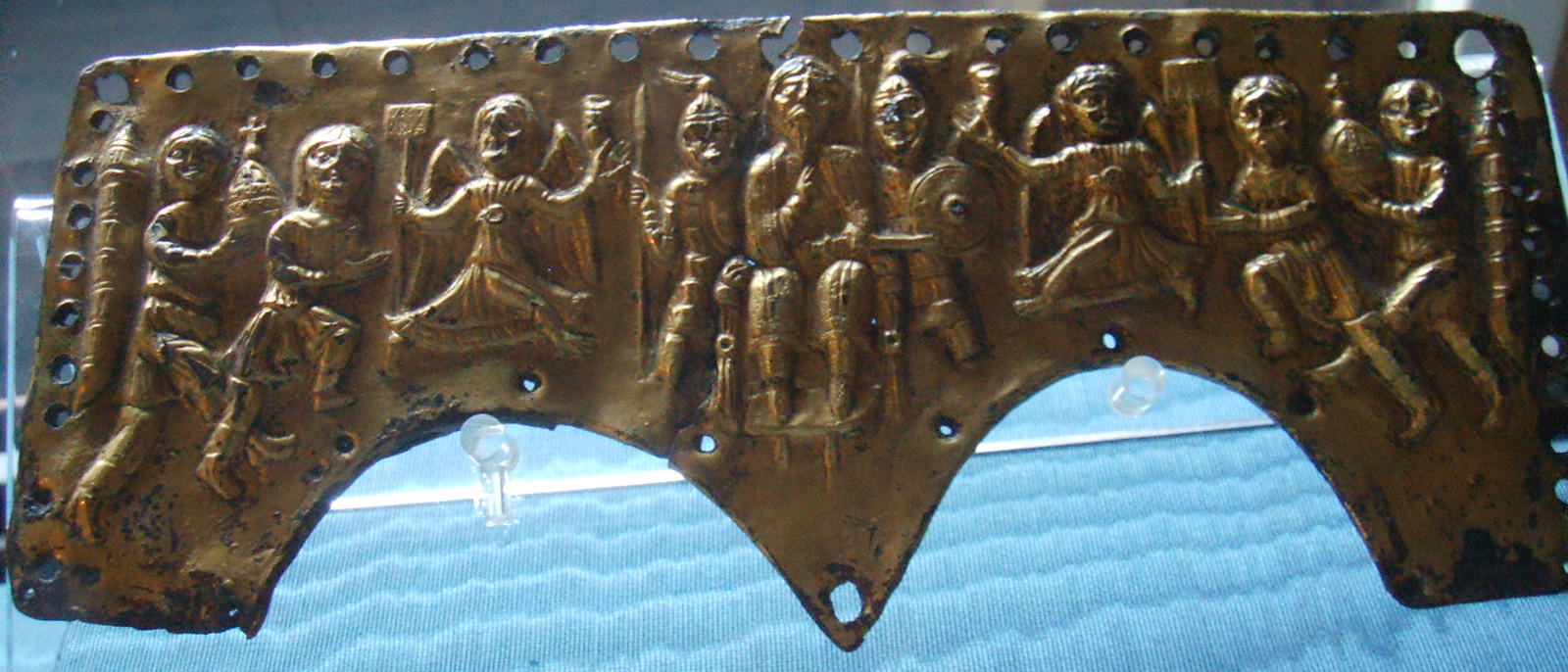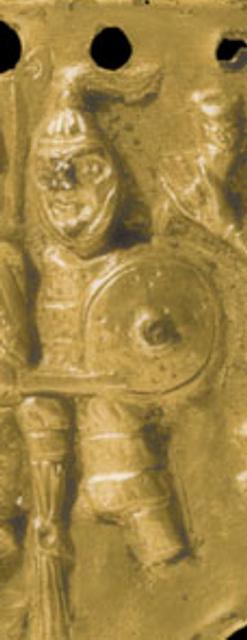
Amazon Audible Gift Memberships
Lombard helmet plate of King Agilulf, 7th century

Photo by Sailko


King Agilulf represented on a 7th cent. helmet plate from Valdinievole, Bargello National Museum; Florence
 Source: Il Palazzo di Sichelgaita |
La Lamina di re Agilulfo, nota anche come Trionfo di re Agilulfo, è un manufatto in bronzo lavorato a sbalzo e dorato, di forma trapezoidale (il bordo inferiore presenta due rientranze semicircolari) che misura 18,9 cm in lunghezza e 6,7 cm in altezza, prodotto da orafi longobardi intorno al VII secolo, riproducente una scena di trionfo. Si trova ora conservata a Firenze nel Museo Nazionale del Bargello.
La figura al centro è circondata dalla scritta punzonata "DN AG IL V REGI" ("Al signore re Agilulfo"), che identificherebbe il personaggio con Agilulfo, re longobardo dal 591 al 616; tuttavia, riguardo a tale identificazione sono stati sollevati dubbi, in quanto alcuni ritengono che la scritta sia una falsificazione operata nel corso del XIX secolo.
The Lamina of King Agilulf, also known as the Triumph of King Agilulf, is an embossed and gilded bronze artifact, trapezoidal in shape (the bottom edge has two semicircular recesses), which measures 18.9 cm in length and 6.7 cm in height, produced by the Lombard goldsmiths around the seventh century, depicting a scene of triumph. It is now preserved in the Museo Nazionale del Bargello in Florence.
The central figure is surrounded by a stamped inscription "DN AG IL V REGI" ("Lord Agilulf King"), which would identify the character with Agilulf, the Lombard king 591-616; however, with regard to this identification concerns have been raised, as some believe the writing is a falsification during the nineteenth century.
Referenced as figure 91 in The military technology of classical Islam by D Nicolle
91. Bronze brow-plate of a helmet, late 6th-early 7th centuries AD, Lombardo-Byzantine, Bargello, Florence
p174 Lamellar armour may also have been used in Byzantium in the pre-Islamic era39 (Figs. 90, 91 and 556).
39. Haldon, "Some Aspects of Byzantine Military Technology from the 6th to the 10th centuries," p. 20.
p222 Plumes are easier to pin down. In 10th century Khurāsān they were known as par santīz.59 They are also very common in the pictorial sources. This is particularly true of the eastern regions, both Islamic and non-Islamic, from where the tall helmet plume or feather may have spread west as part of a general adoption of Persian or Central Asian military fashions (Figs. 618, 67, 90, 91, 196, 330, 422, 439, 455, 464, 574 and 651).
59. Firdawsī, op. cit., p. 427
618. Helmet from Gnezdovo, 10th century AD, Kievan Russian, State Hist. Museum, Moscow (Kir M).
67. Fresco from Eastern Temple, Tumsuk, late 6th century AD, east Turkistānī (in situ. ex-Stein S).
90. Silvered dish, Isola Rizza Dish, late 6th-early 7th centuries AD, Byzantine or Lombardo-Byzantine, Castelvecchio Museum, Verona (Hes).
196A to 196D. Silver plates, A - 'Israelites, Goliath and Philistines,' B - 'David with Saul's armour,' C - 'Saul's soldiers,' D - 'David annointed,' The David Plates 613-629 AD, Byzantine, Metropolitan Museum, New York (WRW).
330A to 330I. Rock-cut statue, early 7th century AD, Sassanian, in it Ṭāq-i Bustān (Fuk).
422A to 422X. Manuscript, Warqa wa Gulshāh, 12th century AD, Azarbayjān, Topkapu Lib., Ms. Hazine 841, ff. 13/15a, 3/6a, 3/6a, 4/7b, 7/9b, 8/10b, 9/11a, 10/12a, 11/13a, 12/13b, 13/15a, 17/18a, 20/20a, 22/21b, 23/22a, 24/23b, 24/25b, 37/35a, 38/36b, 39/37b, 40/38b, 43/40a and 69/66a, Istanbul (Malik).
455. Statuette from Sorcuk, 8th century AD, east Turkistānī, Museum für Völk., Staatliche Museen Dahlem, West Berlin (Coq).
464. Painted paper fragment from Yār, 9th century AD, east Turkistānī, Staatliche Murseen Dahlem, West Berlin (Coq).
574. Relief, late 11th century AD, Italo-Norman, in situ, Church of San Bernadetto, Brindisi.
651. Manuscript, Astrology of Abū Maʿshar al Balkhī, early 14th century AD , Egyptian (?), Bib. Nat., Ms. Ar. 2583, Paris. (Hal).